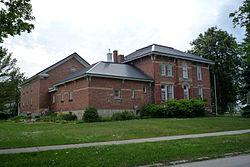Cheboygan, Michigan
Cheboygan, Michigan | |
|---|---|
 Kingston Theater, downtown Cheboygan | |
 Location in the state of Michigan | |
| Country | United States |
| State | Michigan |
| County | Cheboygan |
| Government | |
| • Mayor | Rich Sangster |
| Area | |
| • Total | 7.0 sq mi (18.1 km2) |
| • Land | 6.8 sq mi (17.6 km2) |
| • Water | 0.2 sq mi (0.5 km2) |
| Elevation | 591 ft (180 m) |
| Population (2000) | |
| • Total | 5,295 |
| • Density | 348/sq mi (134.5/km2) |
| Time zone | UTC-5 (EST) |
| • Summer (DST) | UTC-4 (EDT) |
| ZIP code | 49721 |
| Area code | 231 |
| FIPS code | 26-15000Template:GR |
| GNIS feature ID | 0623135Template:GR |
| Website | http://www.cheboygan.org/ |
Cheboygan is a city in the U.S. state of Michigan. As of the 2000 census, the city population was 5,295. It is the county seat of Cheboygan CountyTemplate:GR.
The city is at the mouth of the Cheboygan River on Lake Huron. US 23 connects with I-75 at Mackinaw City and the Mackinac Bridge, about 15 miles (24 km) to the northwest. Rogers City is about 41 miles (66 km) to the southeast. M-27 runs south from the city along the north shore of Mullett Lake to I-75 at Indian River about 18 miles (29 km) to the southwest. M-33 runs due south along the east shore of Lake Mullett to M-68 about 20 miles (32 km) to the south.
History
- Cheboygan began as a Native American settlement. White men came in 1844 and it was made the county seat in 1853. There was a theater built in town in 1877.
- In approximately 1890, Cheboygan became the home port for ferryboats to nearby Bois Blanc, an island in the Straits of Mackinac. The Kristen D is a ferry which operates between Cheboygan and Bois Blanc Island.[1]
- Early in the 20th Century, it was home to the pioneering brass era cyclecar maker Flagler[2]
- In 1944, Cheboygan became the home port of the former U.S. Coast Guard cutter and icebreaker Mackinaw, serving from 1944-2006. Beginning in 2006, the port continued this role as the home dock of the new Mackinaw, a successor cutter.
- The name of the city shares the name of the county and probably has its origin from the Cheboygan River, although the precise meaning is no longer known. It may have come from an Ojibwe word zhaabonigan meaning "sewing needle". Alternatively, the origin may have been "Chabwegan," meaning "a place of ore."[3]
Geography
- According to the United States Census Bureau, the Northern Michigan city has a total area of 7.0 square miles (18.1 km²), of which, 6.8 square miles (17.6 km²) of it is land and 0.2 square miles (0.5 km²) of it (2.72%) is water.
Tourist attractions

Transportation
State trunklines
County-designated highways
 CR C-64
CR C-64 CR C-66
CR C-66 CR F-05
CR F-05
Trails
Demographics


As of the censusTemplate:GR of 2000, there were 5,295 people, 2,146 households, and 1,349 families residing in the city. The population density was 779.5 per square mile (301.1/km²). There were 2,365 housing units at an average density of 348.2/sq mi (134.5/km²). The racial makeup of the city was 91.80% White, 0.51% African American, 4.12% Native American, 0.26% Asian, 0.02% Pacific Islander, 0.38% from other races, and 2.91% from two or more races. Hispanic or Latino of any race were 1.44% of the population.
There were 2,146 households out of which 31.8% had children under the age of 18 living with them, 44.4% were married couples living together, 14.9% had a female householder with no husband present, and 37.1% were non-families. 31.6% of all households were made up of individuals and 14.6% had someone living alone who was 65 years of age or older. The average household size was 2.35 and the average family size was 2.94.
In the city the population was spread out with 25.5% under the age of 18, 8.5% from 18 to 24, 27.0% from 25 to 44, 20.4% from 45 to 64, and 18.6% who were 65 years of age or older. The median age was 37 years. For every 100 females there were 89.4 males. For every 100 females age 18 and over, there were 84.7 males.
The median income for a household in the city was $25,033, and the median income for a family was $32,692. Males had a median income of $28,417 versus $19,559 for females. The per capita income for the city was $14,318. About 15.8% of families and 19.9% of the population were below the poverty line, including 31.0% of those under age 18 and 9.1% of those age 65 or over.
Famous former residents
- Rob Otto: 1988 graduate of CAHS. Radio personality for Sportsradio 1130 WDFN in Detroit, Michigan and television sports commentator for Comcast Television. Otto was one of the original personalities at the former WGFM 105.1 W-Gold-FM in the summer of 1989.[citation needed]
- Scott Sigler: 1988 graduate of CAHS. Contemporary American author of science fiction and horror.
References
- ^ Plaunt Transportation, Inc., Bois Blanc Island Ferry.
- ^ It was a 900 pd (408 kg) vehicle which cost US$450. Clymer, p.166.
- ^ Michigan County names per the Michigan government. Compare History of the name "Sheboygan" and List of Michigan county name etymologies.

